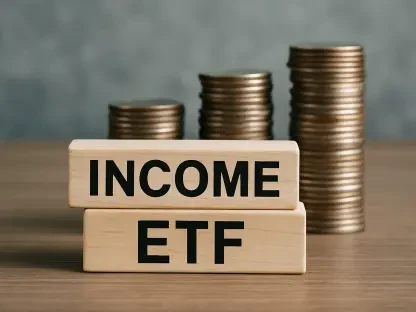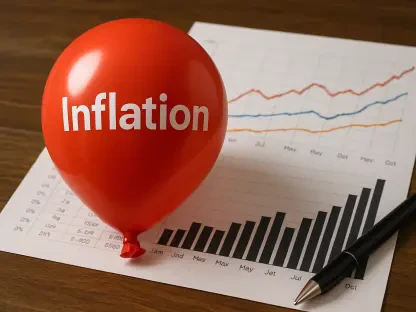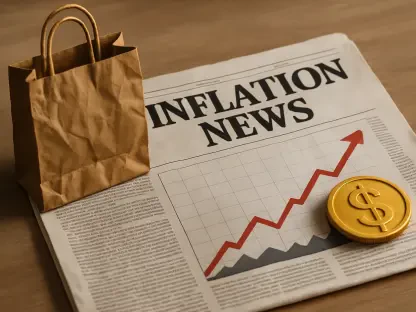On October 8, a remarkable milestone was reached as gold prices soared past $4,000 per ounce, marking a historic moment that has reverberated across global financial markets and captured the attention of investors worldwide. This unprecedented surge, as analyzed by prominent investment banks and institutions, underscores a profound shift in market dynamics driven by a complex interplay of economic uncertainties, geopolitical tensions, and evolving monetary policies. The rally reflects not only a flight to safety amid turbulent times but also a strategic repositioning by investors seeking to hedge against systemic risks. As financial giants weigh in on the factors propelling gold to such heights, their insights reveal a broader narrative of instability and opportunity, painting a vivid picture of a market at a critical juncture.
Drivers Behind Gold’s Historic Rally
Economic and Geopolitical Uncertainties
The ascent of gold beyond $4,000 per ounce is rooted in a confluence of pressing global challenges, with U.S. fiscal concerns taking center stage as a primary driver of investor anxiety. Reports from institutions like Saxo Capital and BNP Paribas point to fears of potential government shutdowns and unsustainable debt levels in the United States as key catalysts pushing investors toward safe-haven assets. Beyond domestic issues, geopolitical tensions—ranging from trade disputes to regional conflicts—add another layer of uncertainty, as highlighted by ING Groep. These simultaneous risks have eroded confidence in traditional economic stabilizers, prompting a reevaluation of where safety truly lies in today’s volatile landscape. The consensus among analysts is clear: gold has become a critical refuge in a world grappling with multifaceted threats.
Adding to the momentum are broader global risks that amplify the appeal of gold as a protective asset. Pepperstone notes that international trade uncertainties and doubts about policy credibility across major economies have intensified the demand for tangible hedges. Unlike other safe-haven options, gold offers a unique sense of stability unaffected by currency fluctuations or governmental policy missteps. This environment of pervasive doubt has led to a significant inflow of capital into gold ETFs, as Saxo Capital observes, with investors reallocating funds from overvalued equity markets. The result is a robust rally that shows little sign of abating, as each new headline of instability further cements gold’s position as a cornerstone of defensive portfolios.
Shift in Investor Behavior
A notable transformation in investor sentiment has played a pivotal role in sustaining gold’s upward trajectory, turning it from a mere safety net into a strategic asset. Pepperstone describes this shift as the emergence of a “conviction trade,” where market participants view any price pullbacks not as warnings but as prime opportunities to buy. This mindset reflects a deep-seated belief in gold’s enduring value amid economic turmoil, a perspective reinforced by declining real yields on traditional safe-haven assets like U.S. Treasuries. Investors are increasingly wary of overexposure to equities, which many see as overpriced, driving a deliberate move toward diversification through gold holdings.
Further fueling this behavioral shift is the sustained demand from central banks, which ING Groep identifies as a significant force behind the price surge. Central banks across the globe are bolstering their reserves with gold, viewing it as a reliable buffer against currency devaluation and economic downturns. This institutional backing lends additional credibility to gold as an investment, encouraging retail and institutional investors alike to follow suit. BNP Paribas adds that the simultaneous presence of multiple risk factors—economic, political, and fiscal—has diminished the appeal of Treasuries, positioning gold as the preferred choice for risk-averse portfolios. This evolving perception underscores a broader trend of prioritizing tangible assets over paper securities in times of uncertainty.
Monetary Policy and Its Market Impact
Federal Reserve and Regional Outlooks
Monetary policy decisions by major central banks are proving to be a crucial influence on the financial landscape, particularly in supporting gold’s remarkable rally. The Federal Reserve’s current accommodative stance, characterized by lower interest rates and a dovish outlook, creates an environment where non-yielding assets like gold become more attractive to investors. This policy direction, as noted by several institutions, reduces the opportunity cost of holding gold, thereby sustaining its appeal amid economic slowdown concerns. The Fed’s approach signals a cautious response to domestic and global challenges, indirectly bolstering demand for safe-haven investments as markets anticipate prolonged uncertainty.
In contrast, regional central banks exhibit divergent strategies that add complexity to the global monetary picture. OCBC Bank suggests that the Monetary Authority of Singapore (MAS) is likely to maintain its existing policy framework with a slight bias toward currency appreciation, preserving flexibility for potential easing if economic conditions deteriorate. Meanwhile, JPMorgan forecasts a more proactive approach from the Reserve Bank of New Zealand (RBNZ), predicting two interest rate cuts in the near future to address weakening economic indicators. These varied responses highlight how localized economic pressures shape central bank actions, influencing not only currency values but also the relative attractiveness of assets like gold in different markets. The interplay of these policies underscores the nuanced impact on investor decision-making worldwide.
Global Policy Implications
The broader implications of central bank policies extend beyond immediate market reactions, shaping long-term expectations for asset classes. An accommodative Federal Reserve policy, as analyzed by financial experts, often correlates with a weaker dollar, which in turn enhances gold’s allure as an alternative store of value. This dynamic is particularly relevant in the context of persistent fiscal uncertainties in major economies, where central banks are compelled to balance growth stimulation with inflation control. The resulting low-interest environment continues to diminish returns on bonds, pushing capital toward commodities that offer protection against currency erosion.
Regional policy differences also reveal potential ripple effects across interconnected markets. For instance, while the MAS adopts a wait-and-see approach to maintain economic stability, the anticipated RBNZ rate cuts could signal to investors a broader trend of monetary easing in smaller economies facing growth challenges. Such actions may encourage speculative flows into safe assets, further supporting gold’s price momentum. Additionally, these policy stances influence currency volatility, which institutions note as a secondary driver for gold demand among investors seeking to hedge against exchange rate risks. This multifaceted impact of monetary policy illustrates how central bank decisions resonate through various layers of the global financial system.
Currency and Bond Market Dynamics
USD/JPY Tensions and Yield Curves
Currency markets are experiencing heightened scrutiny as fiscal uncertainties create pressure points, particularly with the USD/JPY exchange rate. Sumitomo Mitsui has raised concerns that a rate approaching 160 could ignite tensions in U.S.-Japan trade relations, potentially prompting intervention by Japanese authorities to stabilize the yen. This scenario is compounded by domestic policy shifts in Japan, where a fiscally accommodative stance following recent political changes has initially weakened the currency. Such developments highlight the delicate balance between national economic strategies and their international repercussions, with currency fluctuations serving as a barometer of broader geopolitical and trade dynamics.
Parallel to currency concerns, bond markets are reflecting similar strains driven by fiscal uncertainties in key regions. Capital Economics points to a temporary stabilization in global long-term government bond yields but warns of an expected steepening of yield curves due to ongoing fiscal challenges in countries like France and Japan. This steepening suggests growing investor apprehension about debt sustainability and government stability, which in turn fuels demand for alternative safe-haven assets. The interplay between rising yields and currency risks underscores a broader market narrative of caution, where traditional fixed-income securities are losing ground to commodities perceived as more resilient in turbulent times.
Interconnected Market Pressures
The linkage between currency volatility and bond market trends reveals a deeper interconnectedness that shapes investor strategies. The potential for USD/JPY tensions to escalate, as flagged by Sumitomo Mitsui, is not merely a bilateral issue but a signal of wider trade and economic frictions that could impact global risk sentiment. If Japanese authorities intervene to curb yen depreciation, the ripple effects could alter capital flows, potentially strengthening demand for gold as a neutral asset unaffected by currency-specific policies. This dynamic illustrates how localized fiscal decisions can have far-reaching implications for international markets.
Moreover, the steepening yield curves noted by Capital Economics are indicative of a broader reassessment of risk in government debt markets. As fiscal uncertainties persist in major economies, investors are increasingly pricing in higher long-term risks, which diminishes the appeal of bonds as a safe haven. This shift in perception drives capital toward assets like gold, which offer stability independent of governmental fiscal health. The combined pressures in currency and bond markets thus create a feedback loop, where uncertainties in one sphere amplify demand for protective investments in another, reinforcing the current bullish trend in gold prices.
Emerging Financial Trends
Technology and Digital Currency Innovations
The financial landscape is witnessing transformative shifts with the rise of technology-driven investments, notably in AI-related bonds. JPMorgan reports that these bonds have surged to become the largest segment of the U.S. investment-grade market, reaching a staggering $1.2 trillion and surpassing even the banking sector. This growth reflects the increasing integration of technology into core economic activities, as companies leveraging artificial intelligence attract significant investor interest. The trend signals a pivot in market priorities, where innovation and future growth potential are becoming as critical as traditional financial stability in shaping investment decisions.
Equally compelling is the emergence of stablecoins as a new frontier in global finance, with implications for the U.S. dollar’s enduring dominance. Contrary to narratives of de-dollarization, JPMorgan suggests that the adoption of stablecoins could drive substantial demand for the dollar, with market size projections ranging from $500 billion to $2 trillion by 2027. These digital currencies, pegged to stable assets, offer a bridge between traditional finance and the burgeoning crypto ecosystem, potentially reinforcing the dollar’s role in international transactions. This development underscores a pivotal moment where technological advancements are reshaping the foundational structures of currency markets.
Future Market Implications
The ascent of AI-related bonds points to a broader redefinition of value in financial markets, where technological innovation commands unprecedented capital allocation. The $1.2 trillion market size, as highlighted by JPMorgan, is not merely a statistic but a testament to the confidence investors place in AI-driven enterprises to lead economic growth. This shift challenges traditional investment paradigms, prompting portfolio managers to recalibrate strategies to include sectors at the forefront of digital transformation. As technology continues to permeate financial systems, the influence of such bonds is likely to expand, potentially reconfiguring risk assessments across asset classes.
Stablecoin growth, meanwhile, introduces a forward-looking dimension to currency dynamics that could redefine global financial interactions. The projected market expansion to as much as $2 trillion by 2027, according to JPMorgan, suggests a significant integration of digital currencies into mainstream finance, with the U.S. dollar potentially benefiting from increased transactional demand. This trend raises questions about regulatory frameworks and the balance between innovation and stability in monetary systems. As stablecoins gain traction, their impact on traditional safe-haven assets like gold remains an area to watch, offering both opportunities and challenges for investors navigating this evolving landscape.
Reflecting on Market Shifts
Looking back, the dramatic rise of gold beyond $4,000 per ounce on October 8 stood as a defining moment that encapsulated the pervasive uncertainties of the global economy. Insights from leading banks painted a vivid picture of a market driven by fiscal concerns, geopolitical risks, and accommodative monetary policies, all of which converged to elevate gold’s status as a premier safe-haven asset. The simultaneous developments in currency tensions, bond yield pressures, and innovative financial trends like AI bonds and stablecoins added layers of complexity to the financial narrative, highlighting the interconnected nature of modern markets. Moving forward, investors might consider closely monitoring central bank policies and geopolitical developments as critical indicators for gold’s trajectory, while exploring opportunities in technology-driven investments to balance risk and growth. Keeping an eye on the integration of digital currencies could also provide a strategic edge in anticipating shifts in dollar demand and broader market dynamics.









